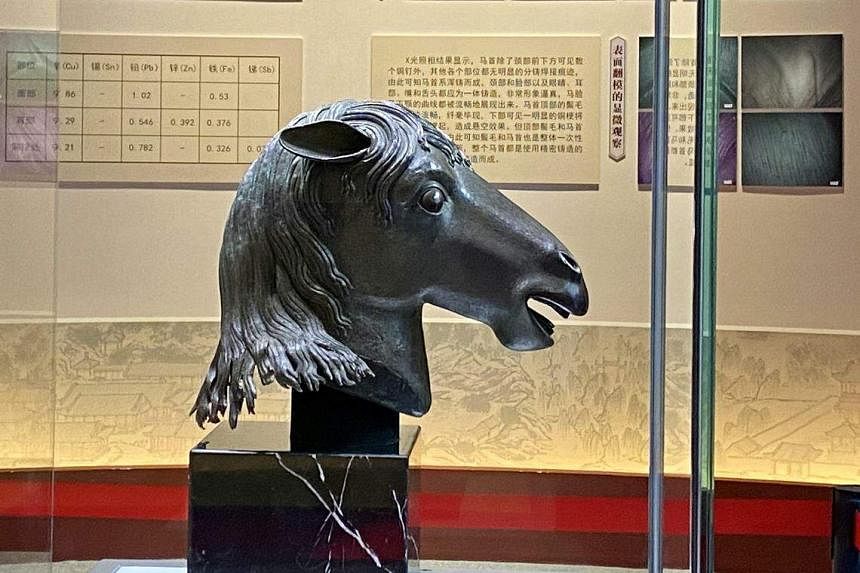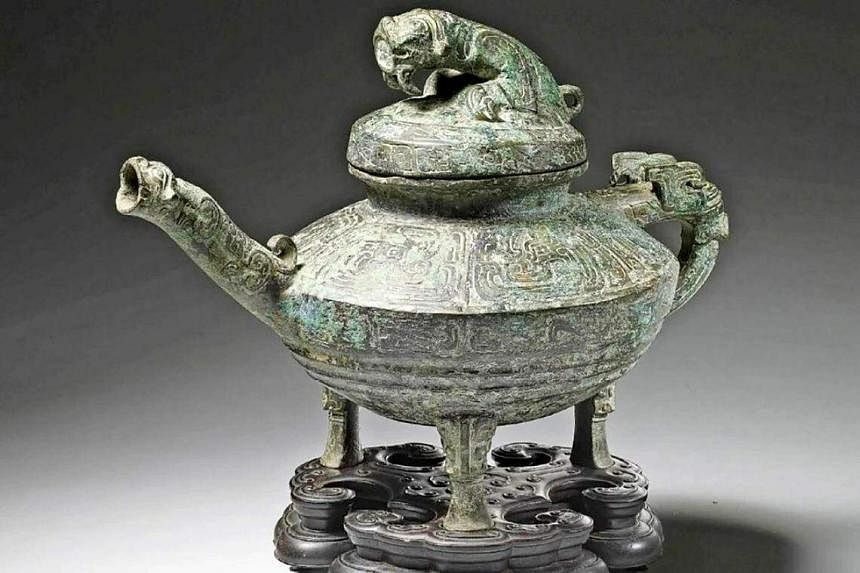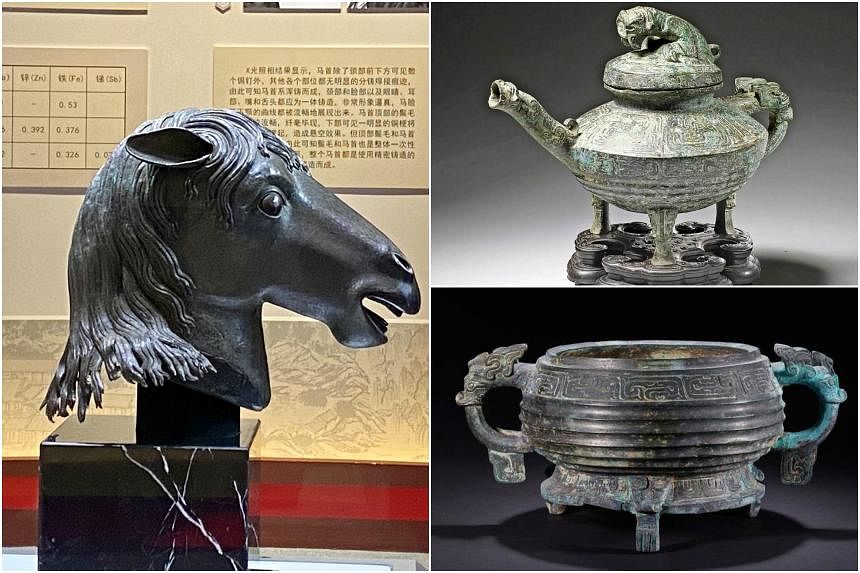BEIJING – Proudly displayed on a stage at the National Museum of China late in March was a row of centuries-old Buddha heads and sculptures that had recently journeyed across the Taiwan Strait.
They were among 30 artefacts, mostly believed to have been stolen from central China’s Shanxi province, that had been donated to Beijing by a Buddhist association in Taiwan.
This was the largest return of relics to mainland China from Taiwan in recent years, state media reported. And they are the latest in a series of lost artefacts to have found their way back to Beijing, as a resurgent China steps up efforts to bring its national treasures home.
Since the turn of the century, China has actively sought the return of its cultural relics that had been stolen or taken abroad.
This pursuit has become more prominent under President Xi Jinping, who has demonstrated a personal interest in protecting such artefacts – and with it China’s history and national pride.
His state visit to Rome in 2019 saw Italy return almost 800 cultural artefacts to Beijing, hailed as the largest repatriation of artefacts to China in over 20 years.
“Cultural relics and cultural heritage carry the genes and bloodline of the Chinese nation,” he has said.
Lost and found
China has lost over 10 million cultural relics since the First Opium War began in 1840, according to estimates from the Chinese Society of Cultural Relics.
Some of these were looted during wartime – most famously during the sacking of Beijing’s Old Summer Palace, or Yuanmingyuan, by Anglo-French forces in 1860, which China regards as a national shame.
Some were stolen and smuggled out of the country by tomb raiders and mercenaries – locals and foreigners alike. And still others were either gifted to foreigners or exported legally from China.
Since Mr Xi came to power in 2012, China has secured the return of over 1,800 lost relics, according to official figures.
Among the most prominent are artefacts that had been taken from the Yuanmingyuan, a resplendent Qing dynasty complex of palaces and gardens that housed many imperial treasures.
A bronze sculpture of a horse head that once adorned the Yuanmingyuan’s famed zodiac fountain clock – featuring 12 animals that spewed water to tell the time – was purchased at an auction in 2007 by the late Macau billionaire Stanley Ho. He donated it to the Chinese government in 2019.

Separately, the rat and rabbit heads from the same fountain were donated to China in 2013 by the wealthy French Pinault family, which had significant business interests in China.
The zodiac heads are worth millions of dollars.
Another recovered Yuanmingyuan treasure that has made waves is the Tiger Ying, a 3,000-year-old bronze water vessel shaped like a teapot. It is so named because its spout and lid have casts of tigers. The vessel was put up for auction in the UK despite China’s protests. It was purchased by an anonymous Chinese individual, and donated to China in 2018.

Other artefacts have gained attention not just for their value, but also for the narratives told of their recovery.
When Feng Xingshu Gui, a 2,800-year-old bronze ritual vessel, was returned to China in 2024 by an American entrepreneur and his mother, the head of China’s national cultural heritage administration lauded this as a significant achievement following from a meeting between Mr Xi and US President Joe Biden.

Homecoming tales
Stories of lost relics “returning home” have been widely publicised in recent years, stoking the Chinese public’s support for repatriation efforts.
Most notably, state broadcaster CCTV in 2021 ran a segment on this in China’s most-watched TV programme – its annual Chinese New Year Eve gala show (chunwan).
Featured during the segment was a recently recovered Buddha head that had been stolen from a cave wall in Shanxi’s Tianlongshan Grottoes almost a century ago. It was purchased and donated to the Chinese government by an overseas Chinese individual in Japan, where the artefact had surfaced for auction.
Mr Zhu Chengru, deputy director of China’s national committee for the compilation of Qing dynasty history, said in a 2022 article that the chunwan segment had increased the level of public attention on the issue of lost relics.
“We have to increase research on the lost relics, recognise the value in having Chinese relics abroad, and promote the return of relics to the motherland through various means,” he wrote.
Fictional takes on the recovery of artefacts too have resonated with local audiences.
In a short web series titled Escape From The British Museum that was released in 2023, the tale of a homesick jade teapot – an anthropomorphised artefact from the museum’s collection – finding its way back to China drew over 270 million views within two weeks of its release on Douyin, China’s version of TikTok.
Ways and means
In the past, China had made sizeable state-linked purchases of its lost artefacts on the open market.
In 2000, the state-owned enterprise China Poly Group purchased three Yuanmingyuan bronze heads – the ox, tiger and monkey – at auctions in Hong Kong. Their total cost was nearly US$4 million (S$5.45 million).
And in 2002, the government set up a special fund to buy cultural artefacts from abroad, with an annual allocation of 50 million yuan (S$9.6 million). Its first purchase was a scroll by Northern Song calligrapher Mi Fu, which cost just under 30 million yuan.
But this approach has been controversial. Experts say that it inflates the price of the relics, and compromises China’s ability to recover stolen artefacts through legal channels.
Law professor Huo Zhengxin from the China University of Political Science and Law told Chinese state media in 2020 that if state-owned enterprises participate in the auction of stolen artefacts, it suggests that the Chinese government recognises the legitimacy of such auctions, potentially hindering future efforts to recover its relics via legal means.
Today, the state’s approach appears to lean more heavily on other channels, such as cooperation with foreign governments, and donations from private entities, who are patriotic, well-meaning, and/or have received Chinese goodwill.
In 2019, the US sent 361 stolen artefacts seized from the home of an American citizen back to China, while Italy did the same with 796 relics that were thought to have been illegally exported from China. These amounted to more than half of the relics recovered under Mr Xi’s tenure.
The 30 Buddhist artefacts donated by Taiwan’s United Association of Humanistic Buddhism, Chunghua, were from “warm-hearted” overseas Chinese collectors, said a representative of the association.
To recover its relics, the Chinese government has signed agreements with more than 20 countries – including the US, Australia, Italy and Greece – to facilitate bilateral cooperation.
It has also rolled out measures such as an online database of looted artefacts, and tightened domestic laws to prevent the illegal outflow of such items.
And it continues to search for more levers for the recovery of artefacts. In 2022, the Chinese People’s Political Consultative Conference (CPPCC), a political advisory body, held a meeting to discuss how the recovery of lost cultural relics could be improved.
Global treasure hunt
China is not alone in seeking to reclaim its lost treasures.
Greece, for example, has long pushed for the return of its Parthenon marbles, among other lost artefacts. And Nigeria has been in pursuit of its Benin bronzes, along with other relics from the ancient kingdom of Benin.
This common cause has not gone unnoticed in China. When then Greek President Prokopis Pavlopoulos asked Mr Xi in 2019 for support in the country’s efforts to reclaim the Parthenon sculptures, Mr Xi replied in the affirmative, noting that China too was working to bring its lost artefacts home.
“Not only do I support you, we should also take action together,” he said in televised remarks.
At the CPPCC meeting in 2022, Mr Qiu Xiaoqi, a former Chinese ambassador to countries like Spain, Brazil and Mexico, floated the idea of establishing an “alliance for the pursuit and return of cultural relics”.
Involving countries that had experienced colonial oppression and shared China’s feelings about the return of lost artefacts, the alliance could generate “international moral pressure” on those that held such relics, he said.
Under Mr Xi, who has spoken extensively about how China is a civilisation with a long history and in 2023 announced a “Global Civilisation Initiative”, China’s efforts to claw back its lost relics are likely to continue apace – potentially with more help from some friends.

